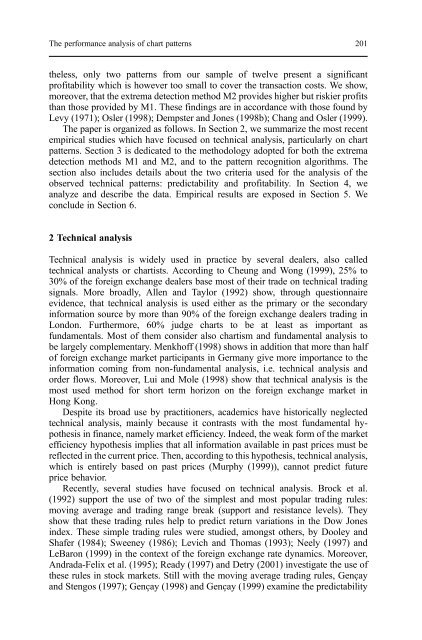recent developments in high frequency financial ... - Index of
recent developments in high frequency financial ... - Index of
recent developments in high frequency financial ... - Index of
Create successful ePaper yourself
Turn your PDF publications into a flip-book with our unique Google optimized e-Paper software.
The performance analysis <strong>of</strong> chart patterns 201<br />
theless, only two patterns from our sample <strong>of</strong> twelve present a significant<br />
pr<strong>of</strong>itability which is however too small to cover the transaction costs. We show,<br />
moreover, that the extrema detection method M2 provides <strong>high</strong>er but riskier pr<strong>of</strong>its<br />
than those provided by M1. These f<strong>in</strong>d<strong>in</strong>gs are <strong>in</strong> accordance with those found by<br />
Levy (1971); Osler (1998); Dempster and Jones (1998b); Chang and Osler (1999).<br />
The paper is organized as follows. In Section 2, we summarize the most <strong>recent</strong><br />
empirical studies which have focused on technical analysis, particularly on chart<br />
patterns. Section 3 is dedicated to the methodology adopted for both the extrema<br />
detection methods M1 and M2, and to the pattern recognition algorithms. The<br />
section also <strong>in</strong>cludes details about the two criteria used for the analysis <strong>of</strong> the<br />
observed technical patterns: predictability and pr<strong>of</strong>itability. In Section 4, we<br />
analyze and describe the data. Empirical results are exposed <strong>in</strong> Section 5. We<br />
conclude <strong>in</strong> Section 6.<br />
2 Technical analysis<br />
Technical analysis is widely used <strong>in</strong> practice by several dealers, also called<br />
technical analysts or chartists. Accord<strong>in</strong>g to Cheung and Wong (1999), 25% to<br />
30% <strong>of</strong> the foreign exchange dealers base most <strong>of</strong> their trade on technical trad<strong>in</strong>g<br />
signals. More broadly, Allen and Taylor (1992) show, through questionnaire<br />
evidence, that technical analysis is used either as the primary or the secondary<br />
<strong>in</strong>formation source by more than 90% <strong>of</strong> the foreign exchange dealers trad<strong>in</strong>g <strong>in</strong><br />
London. Furthermore, 60% judge charts to be at least as important as<br />
fundamentals. Most <strong>of</strong> them consider also chartism and fundamental analysis to<br />
be largely complementary. Menkh<strong>of</strong>f (1998) shows <strong>in</strong> addition that more than half<br />
<strong>of</strong> foreign exchange market participants <strong>in</strong> Germany give more importance to the<br />
<strong>in</strong>formation com<strong>in</strong>g from non-fundamental analysis, i.e. technical analysis and<br />
order flows. Moreover, Lui and Mole (1998) show that technical analysis is the<br />
most used method for short term horizon on the foreign exchange market <strong>in</strong><br />
Hong Kong.<br />
Despite its broad use by practitioners, academics have historically neglected<br />
technical analysis, ma<strong>in</strong>ly because it contrasts with the most fundamental hypothesis<br />
<strong>in</strong> f<strong>in</strong>ance, namely market efficiency. Indeed, the weak form <strong>of</strong> the market<br />
efficiency hypothesis implies that all <strong>in</strong>formation available <strong>in</strong> past prices must be<br />
reflected <strong>in</strong> the current price. Then, accord<strong>in</strong>g to this hypothesis, technical analysis,<br />
which is entirely based on past prices (Murphy (1999)), cannot predict future<br />
price behavior.<br />
Recently, several studies have focused on technical analysis. Brock et al.<br />
(1992) support the use <strong>of</strong> two <strong>of</strong> the simplest and most popular trad<strong>in</strong>g rules:<br />
mov<strong>in</strong>g average and trad<strong>in</strong>g range break (support and resistance levels). They<br />
show that these trad<strong>in</strong>g rules help to predict return variations <strong>in</strong> the Dow Jones<br />
<strong>in</strong>dex. These simple trad<strong>in</strong>g rules were studied, amongst others, by Dooley and<br />
Shafer (1984); Sweeney (1986); Levich and Thomas (1993); Neely (1997) and<br />
LeBaron (1999) <strong>in</strong> the context <strong>of</strong> the foreign exchange rate dynamics. Moreover,<br />
Andrada-Felix et al. (1995); Ready (1997) and Detry (2001) <strong>in</strong>vestigate the use <strong>of</strong><br />
these rules <strong>in</strong> stock markets. Still with the mov<strong>in</strong>g average trad<strong>in</strong>g rules, Gençay<br />
and Stengos (1997); Gençay (1998) and Gençay (1999) exam<strong>in</strong>e the predictability










